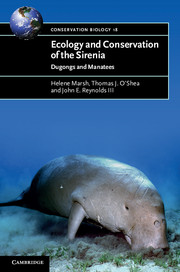Book contents
- Frontmatter
- Contents
- Foreword
- Preface
- Acknowledgements
- 1 Introduction
- 2 Steller’s sea cow
- 3 Affinities, origins and diversity of the Sirenia through time
- 4 Feeding biology
- 5 Behaviour and habitat use
- 6 Life history, reproductive biology and population dynamics
- 7 Threats
- 8 Conservation status
- 9 Conservation opportunities
- References
- List of online supplementary material
- Index
- Plate section
Preface
Published online by Cambridge University Press: 05 January 2012
- Frontmatter
- Contents
- Foreword
- Preface
- Acknowledgements
- 1 Introduction
- 2 Steller’s sea cow
- 3 Affinities, origins and diversity of the Sirenia through time
- 4 Feeding biology
- 5 Behaviour and habitat use
- 6 Life history, reproductive biology and population dynamics
- 7 Threats
- 8 Conservation status
- 9 Conservation opportunities
- References
- List of online supplementary material
- Index
- Plate section
Summary
Preface
This book was born out of passion, frustration, excitement and hope. Readers will perceive all these emotions throughout the following pages. If the hard-won lessons recounted here lead to improved conservation of some remarkable species and their ecosystems, we will have fulfilled our aim.
We have cumulatively spent well over a century studying the various members of the Order Sirenia. Our passions include learning about and trying to conserve manatees and dugongs. The word ‘unique’ has lost its force through inaccuracy and over-use, but we want to reclaim its original meaning here. The sirenians possess suites of morphological, ecological and physiological adaptations that allow them, truly, to hold a unique place in the animal kingdom. Although once a more diverse group, the sirenians are limited now to only four species, albeit with remarkably wide geographic ranges (especially the dugong). Reduced in numbers through much of that range, and with myriad threats to their long-term survival, the sirenians have nonetheless demonstrated tenacity and resilience, hopeful signs that they will persist, if given a chance.
- Type
- Chapter
- Information
- Ecology and Conservation of the SireniaDugongs and Manatees, pp. xi - xivPublisher: Cambridge University PressPrint publication year: 2011



